With a video tutorial and in-depth explanations, learn how to properly measure baking ingredients and why measuring is so crucial in baking.
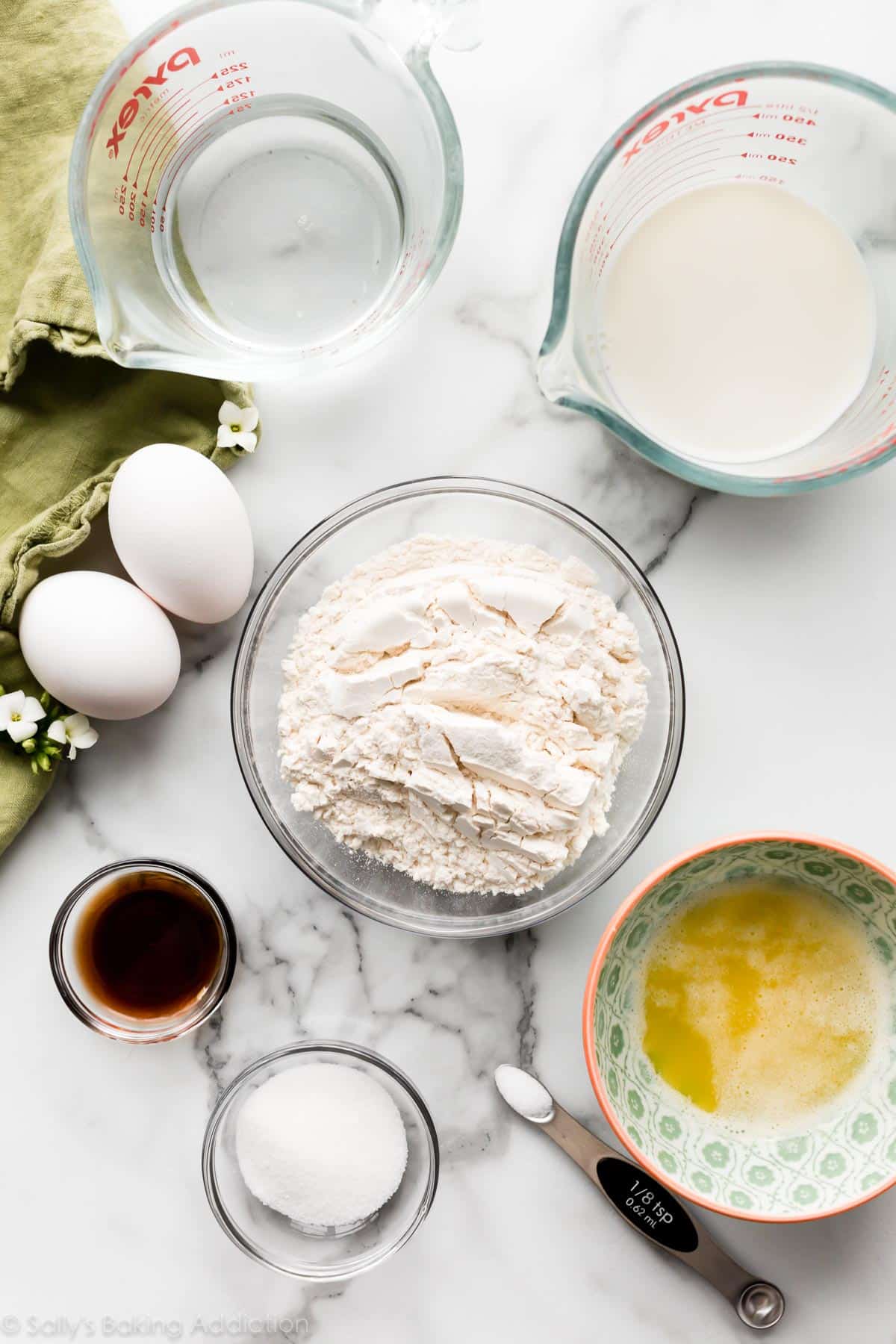
With every recipe I publish, my goal is to help you become a more confident baker. Baking from scratch doesn’t have to be difficult. If you’re set up with the right resources and tools, you can put the FUN back into your kitchen.
Today we’re focusing on something that may seem trivial to you, but it’s the most important step in every recipe you bake. Measuring ingredients properly is imperative. You see, baking is not very forgiving. It’s a science and estimating measurements could spell disaster. While you can easily get away with a handful of this or that when you’re cooking dinner, even the slightest baking miscalculation could turn your soft chocolate chip cookies into rocks. Understanding the correct measuring technique for a particular ingredient will guarantee better baking results. Because the difference between a recipe success and a recipe failure could lie within 1 mis-measured ingredient.
When it comes to baking, it pays off to be a perfectionist. Learn how to properly measure baking ingredients so your next recipe is a success.
How to Properly Measure Baking Ingredients
How to Measure Flour
Flour is the most common mis-measured ingredient. Whether you’re using bread flour, cake flour, all-purpose flour, or any other flours on the market, use the “spoon & level” method. Do not scoop the flour out of the container/bag with your measuring cup because you could end up with 50% more than you need. Rather, using a spoon, scoop the flour into the measuring cup. Do not pack the flour down and do not tap the measuring cup as both cause the flour to settle in the cup. After you’ve spooned the flour into the measuring cup, use the back of a knife to level off the top of the measuring cup.
- Drill this in your head: Spoon & level flour. Do not scoop flour.
- How do I measure sifted flour? If a recipe calls for “1 cup of flour, sifted”—measure the flour, then sift it. If a recipe calls for “1 cup of sifted flour”—sift the flour then measure. It all depends where the word “sifted” is in the ingredient wording. If “sifted” is before the ingredient name, sift before measuring. If “sifted” is after the ingredient name, sift after measuring.
My favorite containers for bulk storing ingredients are these tightly sealed flour keepers. (Affiliate link, I love them!) I own about 10 and recommend them to anyone who asks. I use them for my all-purpose flour, cake flour, bread flour, brown sugar, granulated sugar, and more. They hold 3.8 quarts, which is about one 5 lb bag of flour. I use a label maker to make labels for each—they’re placed on top.
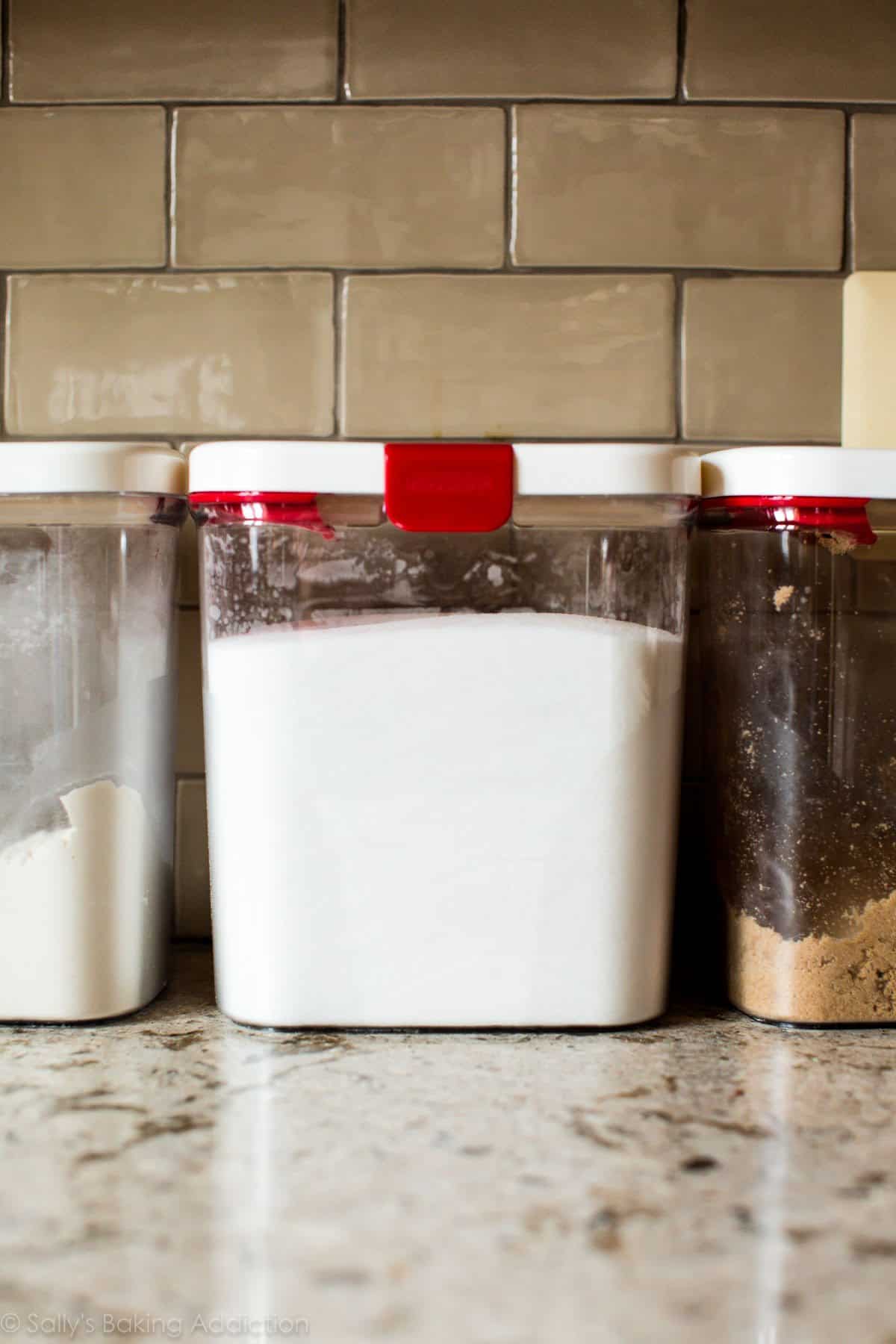
OATS
Make sure you are using the correct type of oats that your recipe calls for. To measure oats, use the same spoon & level method that you use for flour.
Whole oats and quick oats are different and depend on the cut of the oat. I most often use old-fashioned whole rolled oats in recipes like granola, oatmeal bars, and oatmeal cookies. Quick oats are finely chopped whole oats that have a more powdery consistency. When a more powdery, fine oat is ideal in a recipe, I use quick oats. To avoid having two different types of oats on hand in my baking supplies, I make my own quick oats from whole oats. This is very easy: pulse whole oats in a blender or food processor about 5-10 times to break them up to reach the quick oat consistency.
BAKING POWDER & BAKING SODA
Baking powder and baking soda can settle down in their containers over time. Shake it up or give it a stir, then using a measuring spoon, lightly scoop out of the container. Use a knife (or the container if it has a leveler) to level it off.
Always remember the difference in baking powder vs baking soda. Each expire after 6 months, though I find they begin losing strength after 3 months. Write the date on the box so you know when to replace.
DRY YEAST
Standard packets of yeast hold 2 and 1/4 teaspoons, which is 1/4 ounce. If your recipe calls for more or less than 1 standard packet of yeast (or if you are measuring out of a jar or container), measure yeast how you measure baking powder or baking soda.
- Dry yeast can be sold as active-dry or instant. I answer plenty of yeast FAQs, including the difference between yeasts, on my Baking with Yeast page.
- If a recipe calls for dry yeast and you only have cake yeast (aka fresh yeast), use this handy conversion chart.
WHITE GRANULATED SUGAR
Unlike flour, sugar is measured by scooping the measuring cup or spoon into the container/bag until it is overflowing, then leveling it off with the back of a knife. Sugar is heavier than flour, so it’s less likely to pack down into the measuring cup. It’s also more forgiving in recipes than other ingredients because the sweetness of a finished product depends on your tastebuds. However, it is always best to measure the ingredients exactly as the recipe states because sugar crystals are imperative to break down other ingredients. Sugar also aids in proper browning, texture, structure, and stabilization.
BROWN SUGAR
Measure brown sugar like you measure granulated sugar. Unless the recipe states otherwise, brown sugar should be packed into the measuring cup or measuring spoon. Light brown sugar is most common, while dark brown sugar has a slightly stronger molasses flavor. Unless the recipe states otherwise, you can use light brown sugar and dark brown sugar interchangeably.
CONFECTIONERS’ SUGAR (Powdered Sugar/Icing Sugar)
Measure confectioners’ sugar using the same spoon & level method as flour, explained above. Sift confectioners’ sugar if the recipe calls for it. If your confectioners’ sugar is extra lumpy though, it’s best practice to sift it anyway. (No one wants pockets of powdered sugar in their otherwise smooth whipped cream!) As detailed above in the Flour section, 1 cup confectioners’ sugar, sifted means that the sugar is sifted after measuring and 1 cup sifted confectioners’ sugar means that the sugar is sifted before measuring.
COCOA POWDER
Whether you’re using natural or dutched cocoa, measure cocoa powder using the same spoon & level method as flour and confectioners’ sugar. Like confectioners’ sugar, cocoa powder can clump up. If a recipe calls for sifting it, make sure you take the time to do so.
- Further Reading: Dutch-process Vs Natural Cocoa Powder
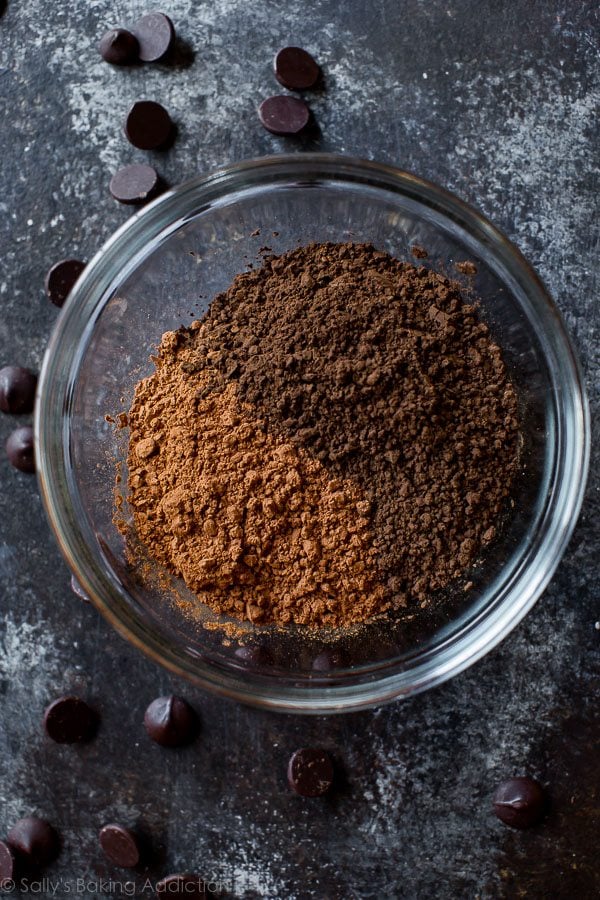
LIQUID SWEETENERS
Liquid sweeteners include maple syrup, molasses, honey, corn syrup, agave, etc. Measure these thick and sticky liquids in dry measuring cups.
- A handy tip: To easily measure sticky sweeteners, spray the inside of the measuring cup lightly with nonstick spray. This will make it much easier to get the sweetener out of the cup!
LIQUIDS
Liquids used in baking such as milk, water, oil, buttermilk (or this buttermilk substitute), etc should be measured at eye level. Using a liquid measuring cup, pour the liquid into the cup. Then, bend down to make sure the liquid is EXACTLY at level with the measuring requirement of the recipe.
SEMI-LIQUIDS
The semi-liquids I’m referring to here are ingredients like sour cream, yogurt, peanut butter, applesauce, mashed banana, etc. Measure these semi-liquid ingredients in dry measuring cups. They are too thick to be accurately measured in liquid measuring cups. Spoon & level, like you do with sugar or flour, then use a rubber spatula to help release the ingredients into the mixing bowl.
- What about butter? Butter is usually sold in sticks, either 1/2 cup (8 Tablespoons) sticks or 1/4 cup (4 Tablespoons) sticks. This makes measuring very convenient—simply slice off however much you need in a recipe. If your butter isn’t in stick form, use a dry measuring cup to measure it. If a recipe calls for melted butter, measure the butter in its solid state, then melt it.
ADD-INS
The add-ins I’m referring to here are chocolate chips, chopped fruit, sprinkles, nuts, etc. Simply scoop or pour them into a dry measuring cup. These ingredients aren’t typically used to make up the structure of a baked good, so there’s no need to be as precise.
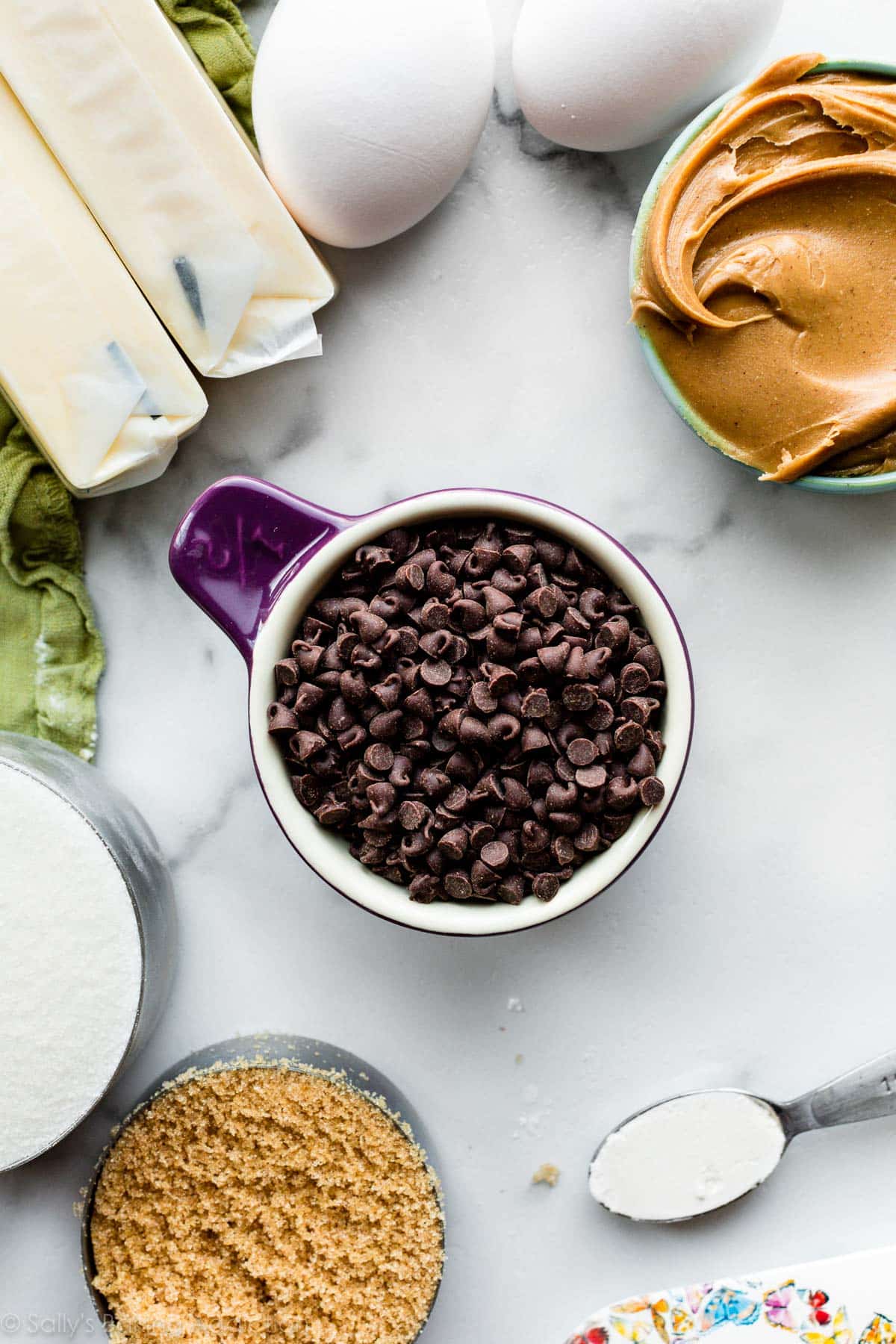
I find the following measurement equivalents helpful.
Dry Ingredient Equivalents:
- 1 Tablespoon = 3 teaspoons
- 1/8 cup = 2 Tablespoons
- 1/4 cup = 4 Tablespoons
- 1/3 cup = 5-1/3 Tablespoons
- 1/2 cup = 8 Tablespoons
- 2/3 cup = 10 and 2/3 Tablespoons
- 3/4 cup = 12 Tablespoons
- 1 cup = 16 Tablespoons
Liquid Ingredient Equivalents:
- 1 cup = 8 fluid ounces = 1/2 pint
- 2 cups = 16 fluid ounces = 1 pint
- 4 cups = 32 fluid ounces = 2 pints = 1 quart
- 8 cups = 64 fluid ounces = 4 pints
- 4 quarts = 128 fluid ounces = 1 gallon
Free Printable PDF for Measuring & Weights
Print out this helpful PDF (2 pages) and have it handy in your kitchen.
**Click this link for the PDF: Sally’s Baking Recipes Baking Conversions Common Weights
Here is a photo preview of page 2:
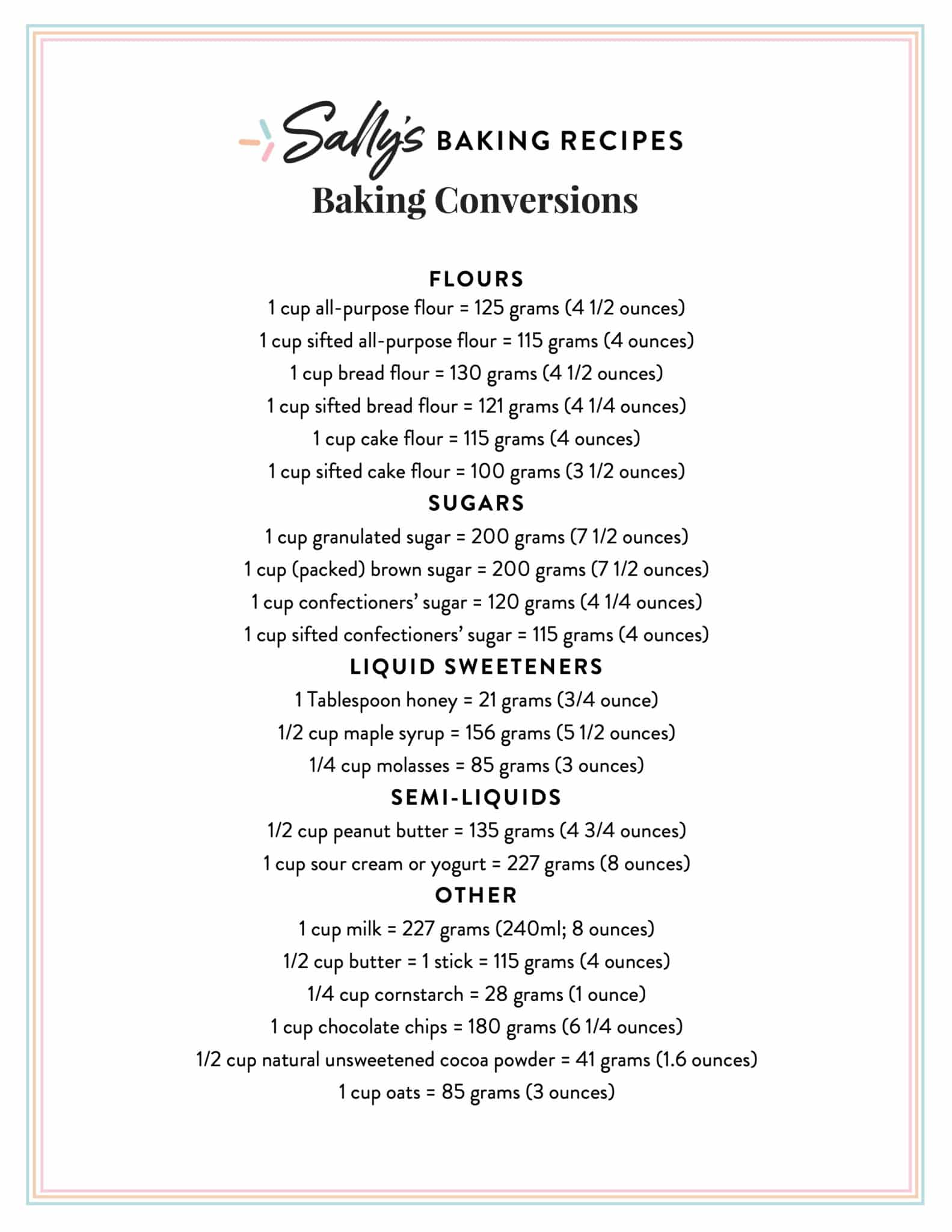
Use a Kitchen Scale to Measure
A cup isn’t always a cup, but a gram or ounce is always a gram or ounce. Metric weights, such as a gram or ounce, are most accurate. Cup measurements are standard where I live, so that is why I offer my recipes in both cup and metric measurements.
When I’m developing recipes for my website and books, I weigh the ingredients in my recipe testing. Some may say weighing ingredients is a waste of time, but if you want the most precise results, weighing your ingredients will help. No need to spoon & level ingredients if you’re weighing them, but if a recipe instructs you sift the ingredient, it’s still best to do so before or after weighing (depending which the recipe instructs).
- Here is (affiliate link) the food scale I own.
- Place your measuring cup on the scale, zero it out, then add your ingredient.
Though it’s best to use the weights given if the recipe supplies them, you can refer to the following list if needed. Different products and brands could have different weights, but this is what I usually measure common baking ingredients to be.
Common Weights
- 1 cup all-purpose flour = 125 grams (4 1/2 ounces)
- 1 cup sifted all-purpose flour = 118 grams (4 ounces)
- 1 cup bread flour = 130 grams (4 1/2 ounces)
- 1 cup cake flour = 118 grams (4 ounces)
- 1 cup sifted cake flour = 105 grams (3 1/2 ounces)
- 1 cup (packed) brown sugar = 200 grams (7 1/2 ounces)
- 1/2 cup butter = 1 stick = 115 grams (4 ounces)
- 1 cup chocolate chips = 180 grams (6 1/4 ounces)
- 1/2 cup natural unsweetened cocoa powder = 41 grams (1.6 ounces)
- 1 cup confectioners’ sugar = 120 grams (4 1/4 ounces)
- 1 cup sifted confectioners’ sugar = 115 grams (4 ounces)
- 1/4 cup cornstarch = 28 grams (1 ounce)
- 1 cup granulated sugar = 200 grams (7 1/2 ounces)
- 1 Tablespoon honey = 21 grams (3/4 ounce)
- 1/2 cup maple syrup = 156 grams (5 1/2 ounces)
- 1 cup milk = 227 grams (240ml; 8 ounces)
- 1/4 cup molasses = 85 grams (3 ounces)
- 1 cup oats = 85 grams (3 ounces)
- 1/2 cup peanut butter = 135 grams (4 3/4 ounces)
- 1 cup sour cream or yogurt = 227 grams (8 ounces)
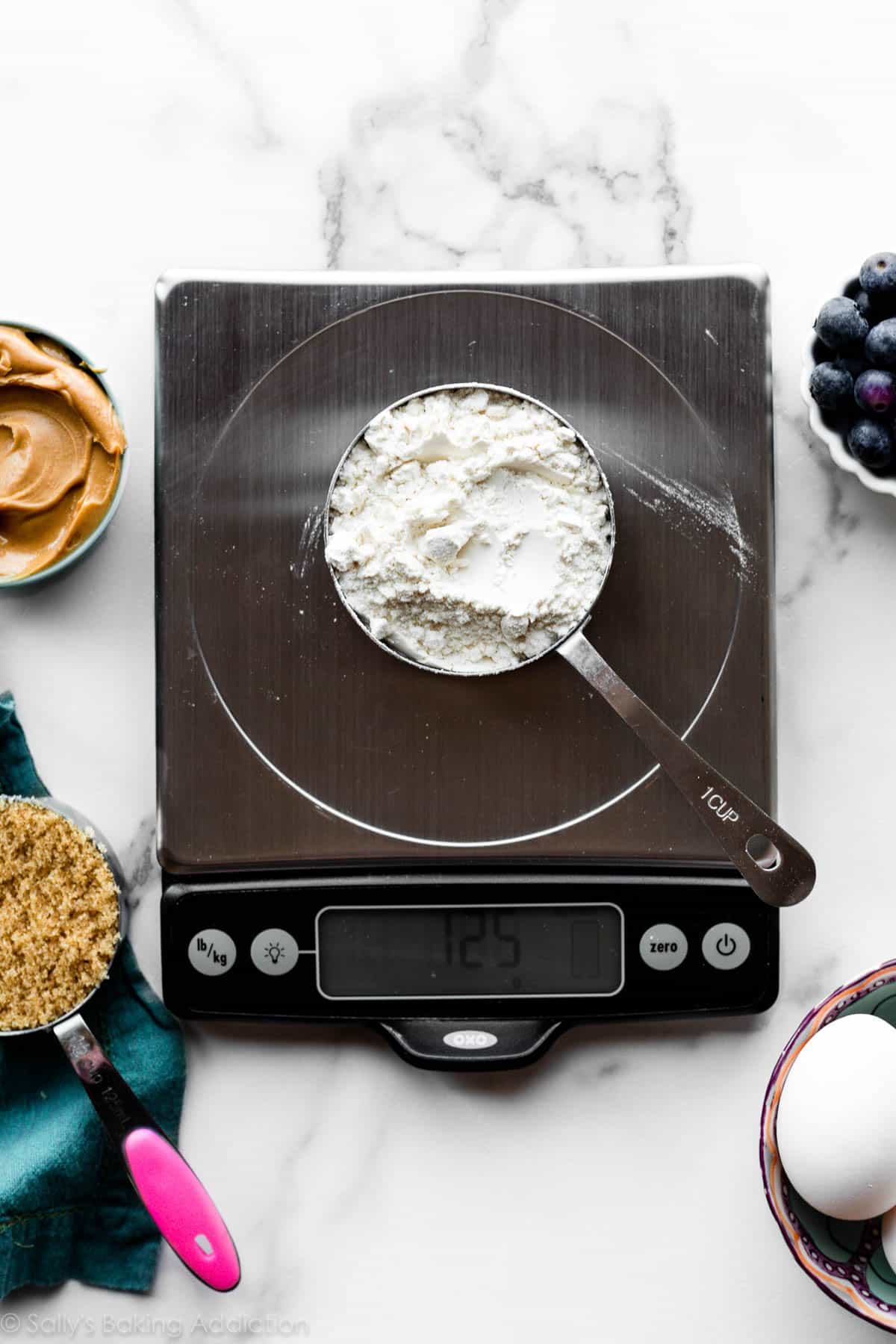
Want to Learn More?
My Baking Tips section is growing!
- Cake Pan Sizes & Conversions
- My 10 Best Baking Tips
- Make-Ahead Baking
- How to Prevent a Dry or Dense Cake
- 14 Best Baking Tools That Every Baker Needs
- 10 Best Pie Baking Tools
- Buttermilk in Baking 101
- How to Decorate Sugar Cookies





















Hi Sally and team, I’m looking forward to learning how to bake bread successfully. I’ve tried buckwheat flour bread and Irish soda bread, both were a disaster. I also tried gluten free and the little loaf I baked was pretty good. So I’m excited to start again with your simple bread recipe on this website. I’ll let you know how I get on. Many thanks Michèle
I always struggle with American recipes because of these cups and how many grams they hold. If you Google it, it varies so much, and it can be 200 grams or 240 grams, and the difference can be crucial when it comes to baking. Therefore, I am so grateful that you write both cups and grams in your recipe! I found this website a couple of weeks ago and have already made four recipes, and they all came out great! Thank you!
This is great information. Thank you. One question on AP flour. I use KA flour. They show 1 cup of AP flour as 120 grams. When making your recipes, should I use the amount of grams published in your recipe or the number of cups converted to grams for the specific brand of flour that I am using?
Hi Kathy, we consistently measure 1 cup of flour at 125g. We recommend following our measurements for best success with our recipes. Hope this helps!
I trying to make cinnamon rolls from scratch I don’t have unsalted butter, is it on to use regular butter if so do I measure less salt for the recipe, if so how much salt do I use
Hi Christy, the general rule when swapping salted butter for unsalted butter is: reduce or add 1/4 teaspoon of salt per 1/2 cup (1/4 lb; 8 Tbsp; 113g) of butter. Here is more helpful info on salted butter vs. unsalted butter in baking.
Hello! I’m back once again to make this goodness that is just absolutely amazing, however I don’t have any plain flour/all purpose flour with me, can I replace it with cake flour or self raising flour, please could you tell me which one(s) will work? Thank you!
It depends on the exact recipe you are looking to make, but typically we do not recommend swapping all-purpose flour with cake flour. We do not recommend self raising flour either, since it’s not always a 1:1 swap with the all purpose flour and leavening agents.
Thank you so, so much for noting that you actually weigh your ingredients for each recipe before sharing them here! I’m in Europe and used to only using weight-based measurements for solids, and trying out American recipes is almost always a gamble — I’ve seen weights for “2 cups of AP flour” given as anything between 220 and 400(!)g, hardly anyone specifies what kind of salt they use (we can’t get kosher salt here, but I’ve learned that it seems much coarser than the table salt we get here so when volume measurements are given, it’s safest to halve them), how much “one stick of butter” is … and buying “American cup measures” here doesn’t really work either, as they seem to vary in volume by almost an entire tablespoon per cup (I’ve seen 236ml, 240ml, 245ml, 250ml to one cup), so thank you for specifying how much a cup holds for you!
I’ve baked three of your recipes so far and was happy to notice that the amounts given work out every time — enough so that I dared start tinkering with the second attempt at one of them (reduced the sugar) while still feeling in control, and it went well. Thank you so much for going that extra mile, I’m sure I’m not the only international reader who appreciates this.
Hi Billie, thank you so much! I’m so pleased to read how helpful the layout of my instructions and recipes have been. I have a big audience in Europe, and my kitchen team and I usually bake and test my recipes using the gram measurements. Your comment is so kind and appreciated!
thanks for the tips! Do you have weights for eggs? I’ve found varying weights for eggs, whites, and yolks across the internet and amongst large eggs themselves. I’m making your white cake and I was just curious how many grams an egg white is for you
Hi Nicole, Egg weights can vary but usually large eggs in the shell are about 57g, and 50g out of the shell. A yolk weighs about 18g and a white 30g.
What is the best way to measure corn starch into a recipe? A scale or dry measuring cup? I need to convert 40oz of cornstarch.
Hi AK, you can use a dry measuring cup or a scale.
What kind of salt do you use? I.e., table vs diamond kosher
Hi Brad, we always use table salt in our recipes unless otherwise noted.
What type of salt do you use in your recipes?
Hi Mees! We always use table salt in our recipes unless otherwise noted.
amazing measuring tips!
The measurements conversion were very accurate and explanatory.Thank you.
I’ve baking my whole life and never knew about the scoop method for flour! Thank you!!!
Thank you, thank you, thank you! I struggle with baking and this article taught me so much. Especially about the measuring flour. I don’t think anyone has EVER told me this.
When it comes to my baking powder and baking soda, I like to buy mine in bulk from my local grocery store. It ensures that I am always using fresher ingredients.
I did find that often times (even when using prepackaged) my baking powder would occasionally have some fine, albeit hard, bits that wouldn’t break down during mixing. To solve this, I measure the baking powder into a very fine strainer. It separates everything nicely leaving the smalls bits behind. Solved the issues I’d had with it.
Thank you so much for the measuring tips! I’ve always been a mediocre baker…now I know why! I wasn’t measuring some ingredients properly. i.e. brown sugar. I always pack it even if the recipe doesn’t say “pack.” Thanks again. I may be able to upgrade my status from mediocre to excellent! Christmas blessings to you and your family!
Thanks for these handy conversions! Does AP flour weigh differently based on brand? KAF vs. Pillsbury, etc. I thought I read somewhere that it does.
Hi Barbara! It can, but the difference is so minimal that it shouldn’t make a difference for home baking.
Sally, can I substitute almond flour 1:1 to make it gluten-free?
Hi Mary, we haven’t tested that, so can’t tell you for sure how it would turn out, but almond flour rarely works as a 1:1 substitute for flour in most baking recipes. Many readers have reported success with using a 1:1 gluten-free flour such as the ones by Bob’s Red Mill and King Arthur Flour, so I would recommend trying those instead. Hope this helps!
Confused. I’ve been weighing everything. Should I ‘scoop and level’ instead?
Hi Jo! You can use either method. Weighing is the most accurate, and if you have a kitchen scale available as you do, that is our recommended method. For those without a kitchen scale, spooning and leveling is the best way to ensure the flour isn’t over measured. Do not scoop and level, as it can pack in the flour. Hope this helps!
Thank you for all your great tips!!
There is no where I’ve found on your site what kind of salt you use, and since your recipes only include volume measurements of salt, I can’t determine if I should use table, kosher, or flaked, let alone which brand of Kosher. It would be great if you would share this. Your recipes would be more attractive.
All of our recipes use table salt unless otherwise noted. Happy baking!
I prefer to use sea salt in a salt grinder which gives a nice fine flaked salt than table salt (found a great one on Amazon).
I typically add just a tad less than the table salt as it is a bit salter tasting.
But it seems to work.
I enjoy all the extra tips you offer. I’ve learned a lot of new things and it makes baking more fun. I’m going to try your ham and cheese scones today to give to a neighbor that has had surgery and won’t be cooking for awhile. (That is, if I don’t eat them all). I love scones, but never made them myself.
Thanks. I appreciate your site and the knowledge you share.
Hope you and your neighbor enjoy the ham and cheese scones, Jeanne!
I prefer to use a scale exclusively in my baking but I’m running into an issue with flour in particular. Often the measurements in a recipe doesn’t match the weight to volume conversion given on the bag of flour. The recipe may say a cup of flour is 115g but the bag of flour says that it’s 130g—which do I go with? I’ve basically split the difference when making any of your recipes but I’m not happy with this. Thanks!
Hi Dane, different brands of flours can be slightly different in weight. We consistently measure one cup of all-purpose flour as 125g and would recommend going with the measurement as written in the recipe. Hope this helps!
Thank you so much for this especially the free PDF conversion chart. Such a shame I didn‘t know all this 40 years ago!
What brand of all-purpose flour do you use when you call for it in cakes (e.g. Banana Cake). I find I can get quite different results with Gold Medal vs. King Arthur.
Hi Ishir, we often use King Arthur brand flour, but use other brands occasionally as well.